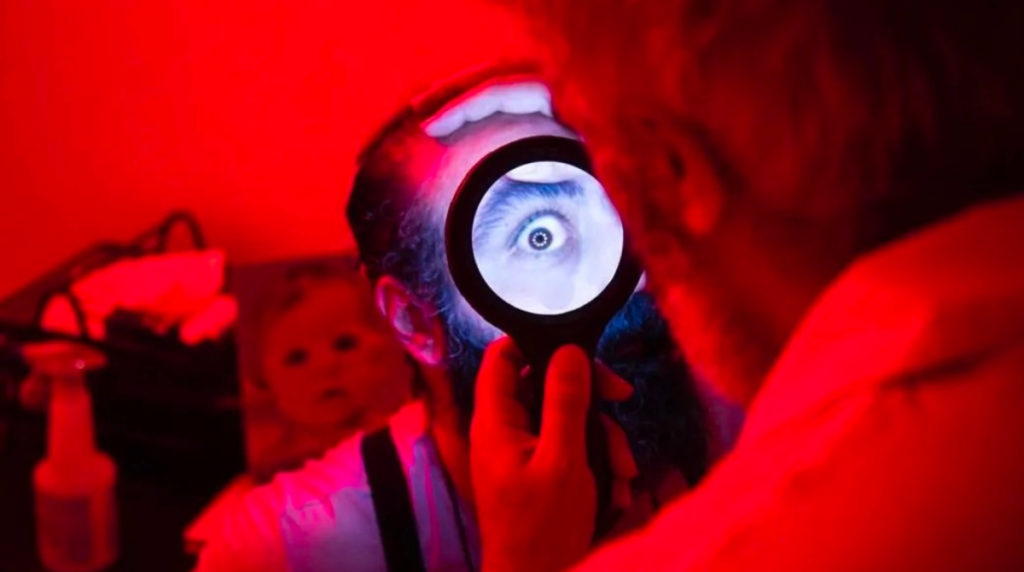Last year’s winner of the “Spirit of Fire festival”, Shahram Ebrahimi, talks about why cinema resembles a symphony, what are the features of working with Iranian actresses and how to make the viewer collaborate with the director.
In 2023, the main prize of the International Debut Film Festival “Spirit of Fire” – the “Golden Taiga” award – went to the film “Parallax” by Iranian director Shahram Ebrahimi. On March 11, the film was shown in Moscow at the “Oktyabr” cinema. The film shows the conflict in a creative family: actress Mahrokh is preparing for her first filming, and her husband Kayvan is trying to stop this. Shahram Ebrahimi spoke in an interview with the chairman of the selection committee of the «Spirit of Fire» film festival, Pyotr Shepotinnik, and film critic Asa Kolodizhner about the confrontation between the old and the new, the misunderstanding between family traditional ideas in Iran, his attitude towards the Iranian film school and experiments with the form.
— The credits say that the film is partly based on real events. To what extent did you base yourself on reality and to what extent on fiction?
— If I myself tried to clearly separate this I would probably just make a classic film in which there would be a direct, clear and obvious narrative. Here I did not separate the truth and the fiction: I learned that such a misfortune happened in real life at the celebration, at a birthday party, a woman, a birthday girl, was set on fire, and she found herself in a critical situation. On this basis, Hassan Attarkha wrote a script that had a pretty classic form: a setup, confrontation and resolution. But after reading it, I realized that if I don’t bring something of my own, it won’t be my individual work, it will be similar to the films of other directors. I was looking for the essence, looking for the very essence between narrative and music. I looked for inspiration in the symphony. I think I managed to find it, and that’s why the story ended up to be like this.

— When you compare a film to a symphony, do you have something specific in your mind related to style and composition? After all, a symphony should have three or four parts.
— Yes, that’s right, a symphony is a three-part structure, and I tried to follow this principle in the film. Each part begins at a specific moment, but doesn’t always end clearly: the first two parts do not find their logical conclusion. The viewer seems to enter the story, but doesn’t fully understand its essence. That was the idea. I mean the first part begins, I introduce the viewer to the main characters, but at the most unexpected moment this part is interrupted, and the next one begins. Once again the viewer meets a new circle of characters. Yes, at first it is difficult for the viewer, but gradually they enter the second part of the story. In the third part this whole narrative comes together. Characters become part of the whole. And this combination, according to my idea, should convey the main idea of the film.
— Weren’t you worried that such a composition would be too complicated for the viewer?
— I was educated in the field of drama and approached the creation of the film using the same criteria that exists in the theatrical art. Yes, indeed films of such a structure are difficult not only to produce and to create, but also to be perceived by the viewer. Because the viewer must participate and collaborate with the creator at every moment of the film. I wouldn’t like it and I’m not ready to give ready-made food for thought to the viewer and I want him to take part in what’s happening.
— Modern Iranian cinema has rich traditions, but it seems that “Parallax” doesn’t really fit into any of them, it does not look like the Iranian mainstream at all. Do you yourself attribute it to any tradition?
— Of course, there are different traditions, as well as an active communication between directors representing different schools and groups. Yes, we get to know each other’s works, discuss them, and talk over different topics. “Parallax” also caused a lot of discussion among my colleagues, the film had many supporters and many critics. The first ones said that yes that’s an unusual form, an unusual presentation, and that if you leave a direct, obvious narrative, it won’t be different from many films that are now being created by the Iranian film industry. But there were also those who said that the picture was too innovative in terms of form, presentation and technology, and the world does not expect these innovations from the East. It’s waiting for the classic plot development.
— How is an Iranian director working with an Iranian actress? The relationship between a man and a woman in your country is not quite the same as in Europe. This probably affects the way you work on the set?
— I believe that an actor or, as in this case, an actress is the creator of her own character. He or she is an engineer, but the director is more of an architect who puts together the final picture. That’s why their joint work is not a conflict, not a competition, but an open, sincere cooperation. Of course, there are contradictions and disputes, but there aren’t any rudeness or cruelty.
— But if, for example, the actress is married, do you have to negotiate with her family about some special rules of behavior on the set?
– No, there are no such restrictions now. Perhaps they once existed in the theater, or in the cinema back in the time when the film industry was just emerging in Iran, but not now. Of course there are religious attitudes that influence the rules of conduct at the state level, but these are not restrictions from the family or a close circle. Women are free to choose their profession and work. And the plot of my film isn’t connected with the restrictions of the social order, but with more personal motives: we see the other side of a husband’s love for his wife, when he is not ready to share even her image with anyone. There are also economic motives here, because the family of the main characters and their son-in-law are at different levels of wealth, and this also affects their relationship.
—Which Iranian director do you consider your like-minded person or a teacher?
Very many. But, of course, among my colleagues the most dear to me are Abbas Kiarostami, Jafar Panahi, Asghar Farhadi. But do you remember – Mikhail Chekhov, who created the system of acting, was a student of Stanislavsky, but at the same time he was looking for his own path of a creative realization.
And I am also looking for my way. I’m trying to experiment with form, image, to make it so that it’s not easy for the viewers to understand me. I want them to tense up and ask the questions. As an Iranian director, I want to use all the tools that the Iranian film industry has and find a new and unusual form.
– Thank you. We are always glad to see you in Khanty-Mansiysk!
— It is a great honor for me to take part in the “Spirit of Fire” film festival, to have the opportunity to show myself and my work. It’s always interesting for me to visit your city, in a country that always breaks off canons and patterns, and also be part of a similar process in art.



